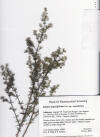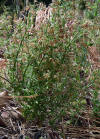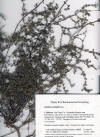|
Galium andrewisii
Kern Co., Caliente Ranch, CA. CNPS
|
Galium angustifolium |
|
Galium angustifolium ssp. gracillimum Nevada, Clark Co.: NW of Glendale along Hwy168, Coyote Springs, SPJ-16256
|
Kern Co., California. S
Sierra Nevada, Greenhorn Mts., mixed conifer forest, Rancheria Road
south of Hwy 155. CNPS
Chapter Field Trip
|
|
Galium angustifolium
|
Galium bolanderi
|
|
Galium californicum Kern Co., California. S
Sierra Nevada, Greenhorn Mts., mixed conifer forest, Rancheria Road near junction with Hwy 155. CNPS
Chapter Field Trip |
Galium californicum
Kern Co., CA: East slopes of Greenhorn Mts. |
|
Galium hallii
|
|
|
|
Galium porrigens |
|
Trees and Shrubs of Kern County (Dec 2012, June 2014) Galium. Annual, perennial herb or subshrub, stems quadrangular, leaves appearing in whorls but interpreted as one pair opposite with one pair of stipules, thus, these pairs not always equal in size; flowers in leafy branched or unbranched scapes (panicles or cymes), or solitary, often appearing with fewer flowers in female plants of dioecious species; calyx reduced to a tubular portion from which the corolla is evident that is disciform or bell-shaped, 3-4 lobed, bisexual or unisexual, with vestigial parts of one or the other in the dominant sex of a flower, these often on separate plants (dioecious); fruit: dicarpia, occasionally one of the carpels aborting, berrylike (baccoid dicarpia) or dry (nucoid dicarpia) and bristly, or with hooked hairs. ~300 spp., worldwide in distribution; 41 in California with numerous subspecies, or varieties in G. porrigens. The key in JM2 (V. Soza) initially requires determining annual vs. perennial, but this distinction is given less weight in the key that follows. Also, annuals and perennial herbs are included for comparative purposes since it can be difficult to separate subshrubs from perennial herbs. Because flowers are tiny, often not more than several mm, hand-lens may be necessary to determine if the plants are dioecious. Therefore, it helps to look for female plants with fruit. Additionally, differences in hair development, leaf shape, apex of leaves, color, length of woody stems, habit of the plant are helpful. The following key also recognizes differences in floral stem branching (inflorescences).Key to species of Galium
1. Low mat to cushion
forming plants, densely leafy, the leaves 1a. Leaves longer than internodes....................................... ssp. andrewsii 1a. Leaves shorter than internodes................................ ssp. intermedium
1. Plants occasionally
mat-like, stem internodes usually evident; leaves
2. Plants woody near
base or branching from a woody root; stem leaves
2. Plants perennial or
annual, but not woody; stems leaves usually in whorls
3. Leaves broadly
elliptic to round, 1–1.5× longer than wide, rounded to apex;
3. Leaves ±elliptical
to mostly narrow throughout, >1.5× longer
4. Floral stems (rachis;
inflorescence paniculate)
exceeding leaves by 2 or more 4. Floral stems all relatively short, <2× the length of leaves (cymose)......................... 7
5. Leaves uniformly
narrow or needle-like, 3-nerved, 5a. Ridges of stems narrower than the grooves.................... ssp. angustifolium 5a. Ridges of stems wider than the grooves.................................. ssp. onycense
5. Leaves wider below
mid region, sword-shaped or strongly rounded near
6. Stems hairless;
floral stems terminal, much-branched, the floral branches
6. Stems hairy; floral
stems terminal and axillary, few-branched, floral
7. Fruit berry-like, hairless...................................................................................... 8 7. Fruit dry, densely white bristly........................................................................... 10
8. Leaves 0.6–2.7 cm;
fruiting pedicels recurved; stems scarcely or not
8. Leaves 0.3–0.8 cm;
pedicels straight; stems with downward curved
9. Plants aging red,
stems densely tangled; leaf tips sharp to touch;
9. Plants not aging
red, stems less tangled; leaf tips with deciduous
9. Plants not aging
red; stems less tangled; leaf tips obtuse to acute
10. Flowers on nodding
pedicels; leaf petiole expanded at base; stems
10. Flowers branches
erect, leaf petiole not expanded, stems woody
11. Plants erect.......................................................................................................... 12 11. Plants creeping, stems often tangled, or in mats...................................................... 13
12. Leaves in whorls of 6, reflexed in age........................................... Galium parisiense 12. Leaves in whorls of 4, not reflexed.................................................. Galium bifolium
13. Fruit without
hairs, perennial, mat forming; northern Kern Co., 13. Fruit with hooked hairs........................................................................................ 14
14. Stems without hairs or at most scabrous, perennial...........................Galium triflorum 14. Stems with hooked hairs along angles, annual................................. Galium aparinae
Galium andrewsii A. Gray 1865. ssp. andrewsii. Needle bedstraw, Phlox-leaved bedstraw. Low rhizomatous dioecious perennial, stems densely crowded into a mat, with shorter erect branches, to 15 cm high, densely leafy; leaves pale green to silvery, in whorls of 4, awl-like, ending in a white to transparent sharp needle-like point, 4–11 mm. Flowers Apr–Jun, greenish white; fruit: berry black, bald. Pine forests, chaparral and foothill woodland below 8,000 ft; southwestern Oregon to Baja California. Type from California. Kern Co.: “Occasional from the Upper Sonoran shrubby associations in the Temblor Range south to the Jeffrey pine forest in the Mt Pinos region; scarce through the mountains to the e Tulare County line” (Twisselmann, varieties not distinguished); 670–2,561 m (CCH). Galium andrewsii ssp. intermedium Dempster & Stebbins 1968. Differs from the preceding by longer internodes, the leaves appearing shorter than internodes. Mostly Coast Ranges and western Transverse Ranges. Kern Co.: Temblor Mts, Bitter Creek Natl. Wildlife Refuge; north facing headwall of Bitter Creek, 1,000 m; head of Cuddy Valley, 1,920 m; Bitter Creek Saddle, 2,468 m; Lockwood Rd, ca. 3 mi above Ozena. Galium angustifolium Nuttall ex A. Gray 1876 ssp. angustifolium. Diffusely branched dioecious rounded subshrub to 1 m high and broad, stems white hairy to bald; leaves in 4's, needle-like, 3-veined, 0.5–3 cm; flowers in umbel-like clusters (cymose) on relatively longer unbranched scapes, red to yellow or cream; fruit bristly. Open rocky places <8,000 ft, California to Baja California, Arizona, Nevada. Type from San Diego Co., CA. Kern Co.: “Occasional, mostly in rocky places in the chaparral in the Temblor Range and the mountains, occurring in the Jeffrey pine forest at Mt. Pinos” (Twisselmann), extending to the Kern River Canyon, Piute Mt., and to Bald Mt. in the Greenhorn Range, 300–1,700 m (CCH). Galium angustifolium ssp. onycense (Dempster 1958, var. onycense) Dempster & Stebbins 1971. Onyx bedstraw. Differs by the stem hairs being shorter than leaf hairs and by the stem ridges being wider than the grooves; flower Apr–Jul. Kern Co. Endemic: “Scarce on the hot slopes of granite blocks and outcrops from Onyx to Walker Pass Station, northeast to Spanish Needle Creek. It extends to the arid Jeffrey pine forest on the rim of the Kern Plateau east of Fay Creek Canyon” (Twisselmann); 1,200–2,200 m (CCH). Plants reported from the Greenhorn Range by Twisselmann belong to ssp. angustifolium. *Galium aparinae Linnaeus 1753. Goose grass. Annual, climbing or prostrate, clinging by hooked prickles; stems brittle; flowers Mar–Jul, white; fruit with hooked hairs. Native to Europe. Galium bifolium S. Watson 1871. Low mountain bedstraw. Erect stemmed annual; stems simple or sparingly branched, without hairs , 5–15 cm high; leaves in whorls of 4, unequal pairs, reduced to one pair at base of flowering stems; flowers Jun–Sep, solitary on slender pedicels 3–10 mm, arising from leaf axils, while, 3-lobed, bald, white; fruit with hooked hairs. Rocky Mts, Cascade Ranges, Coast Ranges, Sierra Nevada, from British Columbia to San Bernardino Mts. in California, east to Montana, Colorado, Utah, and Nevada, 1,500–3,700 m. Type from Wasatch Mts., Utah. Galium bolanderi A. Gray 1868. Bolander's bedstraw. Subshrub <40 cm; stems stout, without hairs, or with short pressed hairs on angles; leaves unequal in whorls of 4, narrow to elliptic, tapered to base and tip, with a soft apical point, 6–27 mm. Flowering Mar–Aug, flowers inconspicuous, male and females on separate plants, the male in clusters of leaf axils, the female solitary in a leaf axil, red to yellow; fruit a baccoid dicarpia, purplish, bald to hairy, separating into its carpellary parts, each fruiting carpel kidney shaped. Rocky slopes of open conifer forest and dense chaparral, in much of California west of the desert, 500–8,000 ft. Type from Mono Trail, Yosemite National Park. Kern Co.: “Occasional, Douglas oak woodland to yellow pine forest south to the Tehachapi Mountains” (Twisselmann), 488–2,560 m (CCH). Galium californicum, distinguished by wiry herbaceous stems, occurs in the surrounding Coast Range and Mohave Desert counties, it may be expected in Kern Co. Galium hallii Munz & I. M. Johnston 1923. Nodding bedstraw. Dioecious subshrubs with a branched woody crown, from which many stems arise to 60 cm, sprawling or climbing over other plants; bark white, exfoliating; stems and leaves desnely short grayish white hairy; leaves in 4's, with expanded petioles, blades ± elliptical and narrowed to an acute or obtuse apex, not sharp to the touch, 0.5–1.7 cm long, margins revolute, 3-veined with stronger midvein and weaker yellowish lateral veins; flowers May–Aug, yellowish, hairy, in axillary branched drooping scapes; fruit densely hairy, hairs to 2mm, straight, white or gray or blue or reddish brown. Dry rocky north-facing slopes and canyons, mostly 4,000–7,000 ft, pinyon-juniper wd, sagebrush scrub, Eastern Sierra Nevada, White Mts., Plumas Co to San Bernardino Mts., Providence Mts., Kingston Mts., to Transverse Ranges. Type from Coldwater Fork of Lytle Creek, San Gabriel Mts., gravelly ground, 5,200–5,700 ft. Kern Co.: Breckenridge Mt., Piute Mt. above Bodfish, Cannell Meadow on Kern Plateau, Erskine Creek, Horse Canyon-Cane Canyon Saddle along Pacific Crest Trail in Scodie Mts., trail to Owen Peak, Mt Jenkins, Oak Creek Pass in Tehachapi Mts., ridge west of Tecuya Mt., 800–2,300 m (CCH). Galium hilendiae Dempster & Ehrendorfer 1965 ssp. hilendiae. Hilend's bedstraw. Dioecious, woody only 3–4 cm above base, stems numerous, 13–45 cm; leaves in 4's, flat, ± elliptical to sword-shape or round, 5–18 mm, tapered to acute apex, not sharp to touch; flowers May–Jul, pink, bell-shaped, hairy; fruit with long hairs. Dry rocky canyons, Mojave Desert, 1,300–2,700 m. Type from north slopes of San Bernardino Mts., Cushenbury Canyon. Kern Co.: Rare. Eastern Sierra Nevada, Owen Peak region, Grapevine Canyon, 1,159 m (Fraga et al., 19 May 2003). Galium matthewsii A. Gray 1883. Dioecious, erect-stemmed subshrub to 45 cm high; stems many, branching near base, interwoven, slender, stiff, hairless or scarcely scabrous; leaves in 4's, remote (internodes much longer than leaves), 2–10 mm, sword-shaped or with a rounded base (ovate) and long tapered to apex, sharp to the touch, arched and leathery, 1-nerved; flowers May–Aug, many in much-branched scapes, saucer-shaped to bell-shaped, yellow, with long straight hairs. Dry rocky slopes and washes, sagebrush and shadscale scrub, pinyon-juniper wd, 1,100–3,00 m, Eastern Sierra Nevada and Mojave Desert Mts. Type from Panamint Mts., Willow Creek Canyon, Inyo Co., CA. Kern Co.: Eastern and southern Sierra Nevada,: Short Canyon, Jawbone Canyon, and northeast slopes of Spanish Needle. Noted by Twisselmann as “rare in sand at the base of a massive granite canyon wall at the head of Short Canyon.” Also, Erskine Creek, Piute Mts. (Purpus, Jun 1897, cited by Dempster in Brittonia). Galium munzii Hilend & J.T. Howell 1934. Dioecious subshrubs; stems many from a woody densely branched base, creeping to erect, exfoliating, shortly stiff hairy, to 35 cm high; leaves in 4's, wider and rounded below mid region (ovate), subequal, 5–12 mm, mucronate, 1-nerved, flowers May–Jul, axillary on a long branch then shortly thrice divided (cymose) with subtending pairs of leaves, greenish to brown; fruit white bristly. Eastern Sierra Nevada, desert mountains, to Utah. Type from Bonanza King Mine, 3000 ft, east slopes of the providence Mts., San Bernardino Co., CA. Kern Co: Ridgeline to SE of Oak Creek Canyon, just SW of wind turbine facility. 1,534 m (S. White & J. Wood, 3 Jun 2009, RSA-CCH). Galium nuttallii A. Gray 1852 ssp. nuttallii. Nuttall's bedstraw. Woody climber to 2 m with raspy hairs on stems and leaves, the leaves in whorls of 4, short and uniformly narrow or broader near base, 3–8 mm, ending in a sharp hair point; flowering Mar–Jun, flowers yellowish green; fruit described as fleshy. Common on dry slopes below 2,000 ft, Baja California to Oregon. Type from San Diego, CA. Kern Co.: “Scarce, Douglas oak woodland and chaparral on the west slope of the mountains south to Bear Valley” (Twisselmann), no records in CCH. *Galium parisiense Linnaeus 1753. Wall Bedstraw. Erect, slender stemmed annual, 15–70 cm; stems minutely scabrous; leaves in whorls of 6, narrow, wider aove or below mid region, reflexed in age, 5–12 mm, ending in bristle. Flowers Apr–Aug, on thread-like branches, upper leaves reduced or absent, greenish white, 1mm; fruit hairs hooked, or absent. Native to Mediterranean. Galium porrigens Dempster 1974 var. tenue (Galium nuttallii var. tenue Dempster 1968) Dempster 1974. Climbing bedstraw. Dioecious, woody vine, clinging by recurved scabrous hairs; stems slender, to 1.5 m long; leaves narrow, 3–8 mm, in whorls of 4; flowering Feb–Jul; flowers yellow to red; dicarpia glabrous. Chaparral, oak and pine woodlands, 400–3,600 ft ; Oregon and California, mostly foothills surrounding the Great Valley. Type from trail to Pine Log, South Fork of the Stanislaus River, Tuolumne Co., CA. Kern Co.: North-facing slope above Poso Creek (about 2 mi due se), 761 m (Charlotte Smith, 14 May 1942); saddle in ridge northeast from Pine Mountain south of Granite Station (Dempster & Charlotte Smith, 6 Apr 1966); Flying Dutchman Creek, 1.5 mi. west of Caliente-Bodfish Road on Breckenridge Mtn. Road, southwest of Havilah (D. Charlton, var. not specified, 21 Jul 1989). Galium sparsiflorum W. Wright 1900. Stems loosely tufted from a woody branching root-rhizome complex, erect to ascending to 50 cm high; stems scabrous; leaves in 4's, 6–25 mm, elliptic or wider below mid region, abruptly tapered to a soft point, 3-nerved, shortly petioled; flowers Jun–Aug, usually several or more on branched scapes arising from leaf axils, saucer shaped, 2 mm across, yellow. Fruit a berry, usually bald, occasionally with some hair. Shady places in montane coniferous forest, Sierra Nevada, Plumas to Kern Cos., 5,500–8,000 ft. Type from Big Meadows, Plumas Co., CA. Kern Co.: Rare: Antelope Canyon, Tehachapi Mts. (Dudley, 7 Jun 1895, NY-CCH). Galium trifidum Linnaeus 1753 ssp. columbianum (G. columbianum Rydberg 1917) Hultén 1937 [G. trifidum var. pacificum Wiegand 1897]. Perennial or possibly annual, but not known to be woody. Stems 10–40 cm, slender, tangled, with retrorse stiff hairs along angles of stems; leaves in 4's or 5's or 6's to a whorl, narrowly elliptic to spoon shaped, 4–19 mm long with minute stiff hairs on leaf margins and midvein; flowers Jun–Aug, 3 parted, white or pink, bisexual, without hairs, fruit a nucoid dicarpia, black, hairless. Widespread, to 10,000 ft. Type from Placer Co., CA. Kern Co.: Sunday Peak, 1,800–2,133 m (CCH). Galium trifidum ssp. subbiflorum (Wiegand 1897, var. subbiflorum) Puff 1919. Plants matted, stems < 15 cm. Flowers Jun–Sep; fruit smooth, each carpel 1 mm diam. Moist places, British Columbia to southern California, east to Rocky Mts. Type from Colorado. Kern Co.: Sunday Peak, 1,800–2,133 m (CCH). Tiger Flat Campground, east of Sunday *Peak. 2012 m and east slope of Sunday Peak, 2,134 m, “scarce in wet usually shaded places in the red fir and ponderosa pine forests south to Greenhorn Mountain Park” (Twisselmann, included ssp. columbianum as var. pacificum Wiegand in CCH). Galium triflorum Micheaux 1803. Sweet-scented bedstraw. Perennial with many radiating crawling stems from a central root, 20–80 cm, ascending near their tips, stems bald or with minute hairs; leaves in whorls of 6, elliptical to wider below or above the mid region, long to short tapered to apex, 0.6–4 cm; flowers May–Jul, several on leaf axillary stem (peduncle), cream to pink, bisexual, fruit with hooked hairs, the hairs soft, white to brown. Damp places below 10,000 ft, Alaska to southern California. Type from Canada. Kern Co.: Greenhorn Mts., 8 mi north of Lake Isabella off Hwy 155, 1,768 m (M. Theroux, 16 Aug 1981, UCR-CCH).
|
|

















